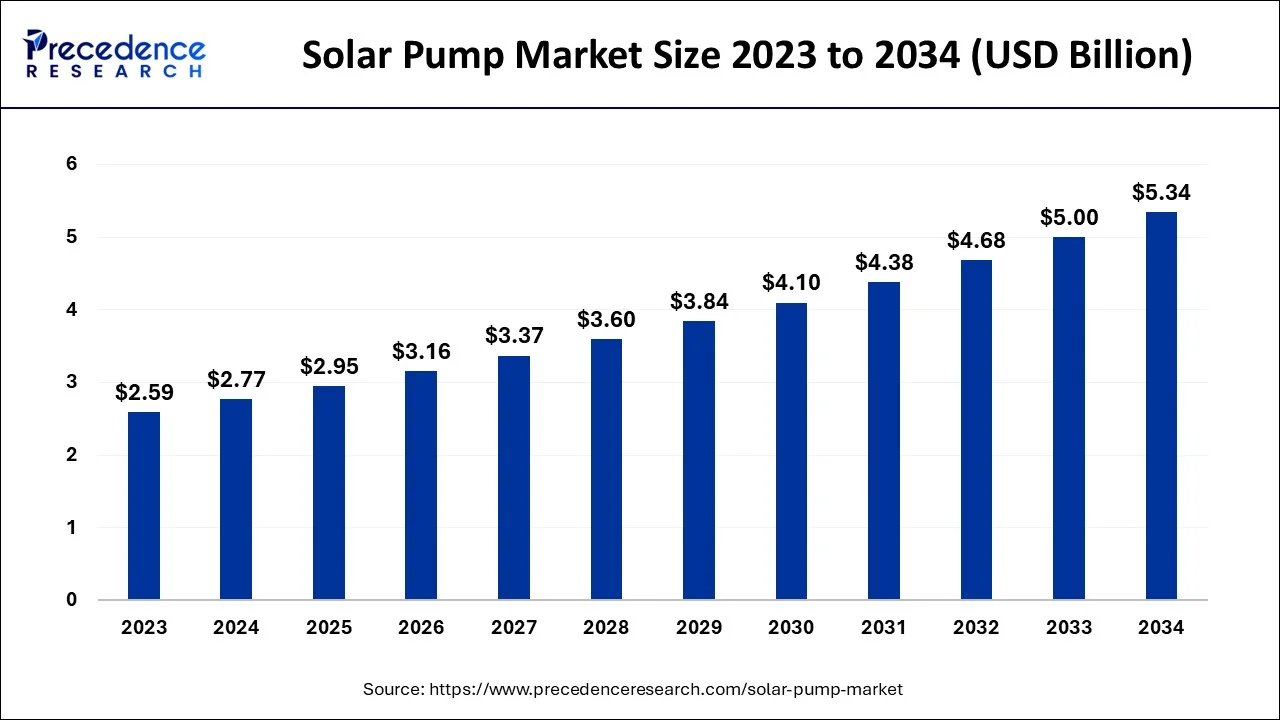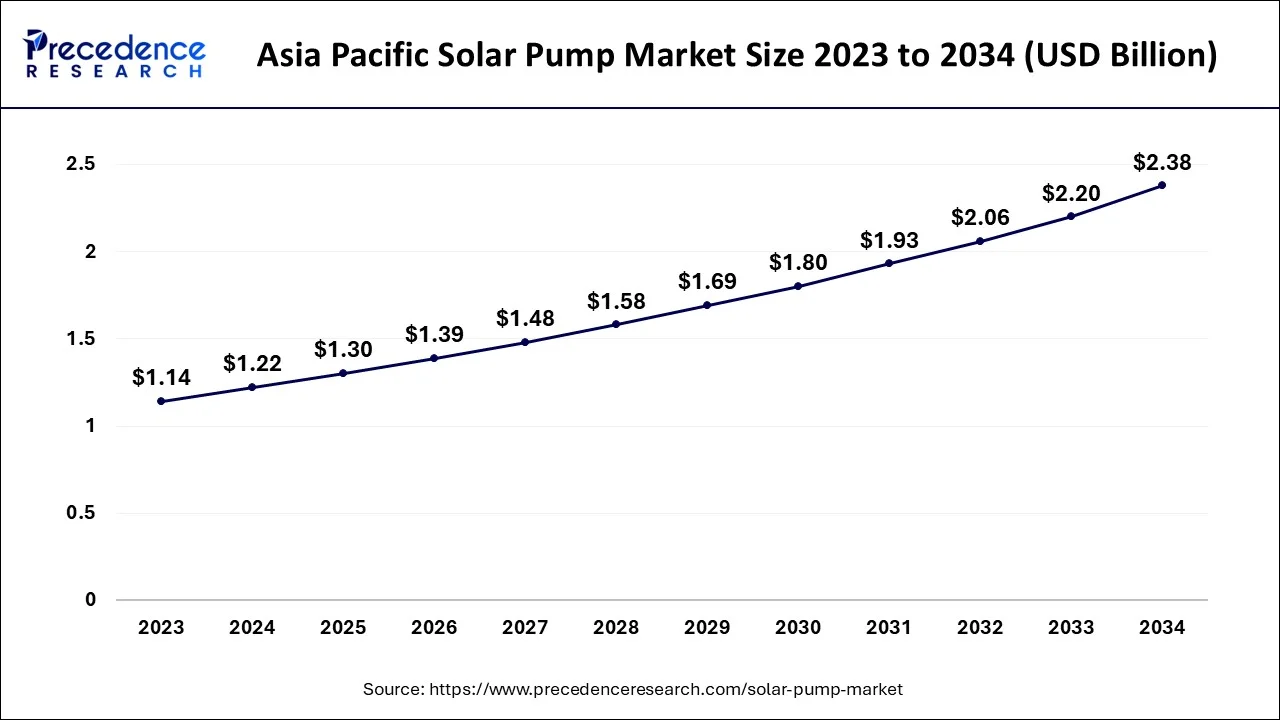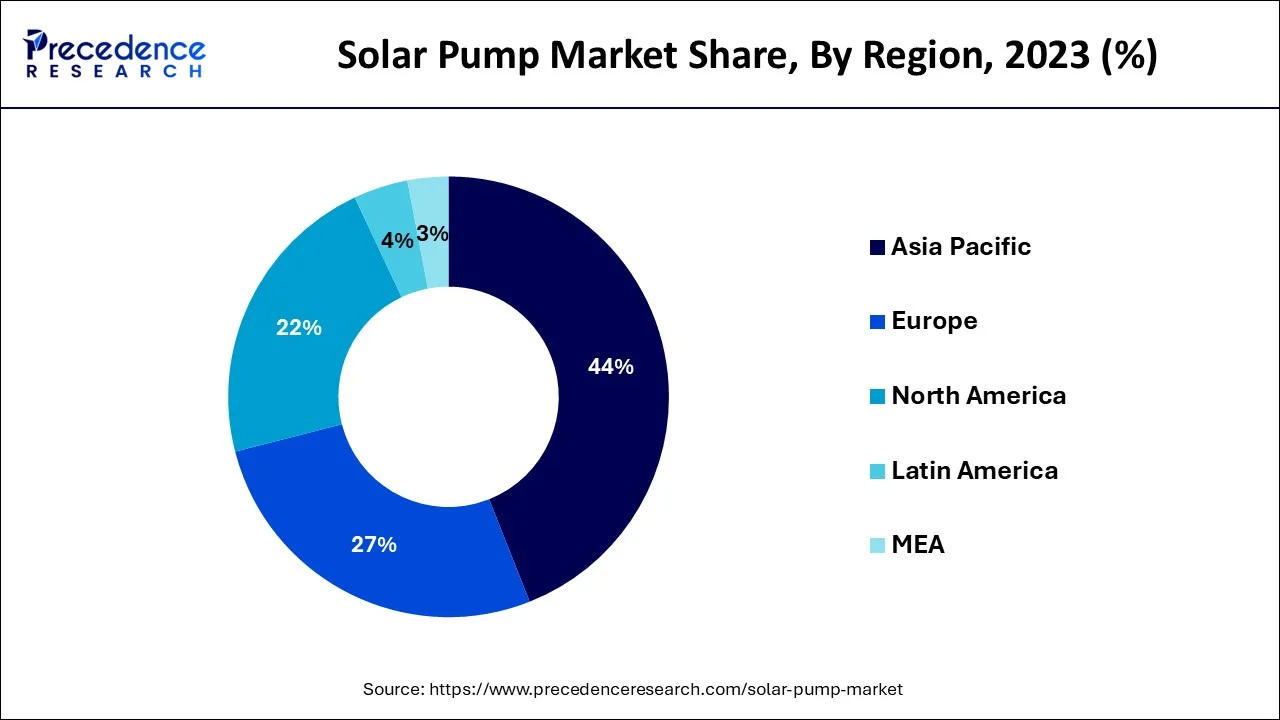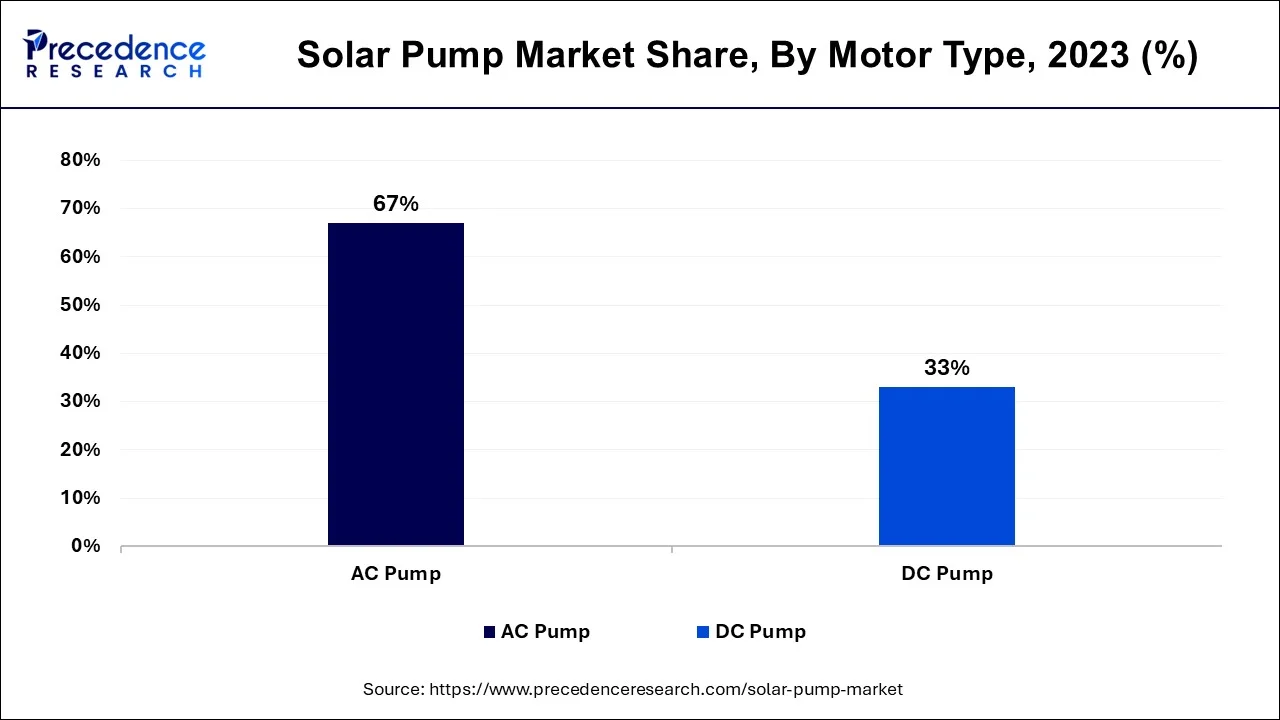October 2024
The global solar pump market size accounted for USD 2.77 billion in 2024, grew to USD 2.95 billion in 2025 and is predicted to surpass around USD 5.34 billion by 2034, representing a healthy CAGR of 6.80% between 2024 and 2034.
The global solar pump market size accounted for USD 2.77 billion in 2024 and is anticipated to reach around USD 5.34 billion by 2034, growing at a CAGR of 6.80% from 2024 to 2034.

The Asia Pacific solar pump market size is evaluated at USD 1.22 billion in 2024 and is predicted to be worth around USD 2.38 billion by 2034, rising at a CAGR of 6.92% from 2024 to 2034.

By region, the Asia Pacific market has held the highest revenue share in 2023.
Due to the rising need for renewable energy sources, particularly in the agricultural sector, the United States is one of the key markets for solar pumping systems in North America. Over two million farms, or about 30% of the nation's total land area, are located in the United States, according to the U.S. Department of Agriculture (USDA). Different types of pumps are used on these farms for a variety of tasks, including irrigation and watering cattle. As a result, the market for solar pumping systems in North America is anticipated to increase due to the rising demand for solar pumps from the agricultural sector throughout the course of the projected period.

Solar pumping systems are employed in drinking water applications, such as community water projects and rural off-grid locations, in addition to agriculture. Over two billion people worldwide lack access to clean drinking water, according to WaterAid America. As a result, the demand for clean drinking water in distant locations is increasing, which is anticipated to drive up solar pump demand in North America throughout the projection period. The market for solar pumping systems in North America is dominated by companies like Xylem Inc., Franklin Electric Co., Grundfos, and KSB SE & Co. KGaA. These players are well-established in this area and provide their clients with a large selection of goods. Due to the power-generating component, which has led to a significant increase in clean energy and is therefore expected to fuel the market growth for solar water pumps throughout the area, market dynamics have been favorable in Latin America.
The solar-powered water pump sector is expanding across the Middle East and Africa, particularly in sub-Saharan Africa, as a result of recent technological advancements and falling costs. Traditional forms of water pumps include diesel pumps and electric pumps that are connected to the grid, but with the dramatic reduction in the price of PV panels, solar-powered water pumps have started to gain traction and will continue to expand throughout the projected period.
A solar-powered device known as a solar water pump moves water for a variety of uses, including irrigation, community water supplies, and potable drinking water. Utilizing solar water pumps has reduced the need for energy-dependent resources like coal, gas, and diesel. In the upcoming years, increased investment in agricultural applications is anticipated to drive market expansion.
The market for these units will increase due to rising interest in reducing carbon emissions and great adoption rates of renewable energy devices. Low operating costs and the depletion of fossil fuel supplies are two major reasons that will propel the expansion of the solar pump industry. Over the anticipated time frame, increased government subsidies provided to farmers and manufacturers as well as the adoption of strict rules to reduce carbon footprint would increase product penetration. Solar pumps will be in high demand due to little access to energy, high reliance on rainfall, and logistical difficulties with fuel delivery in remote locations. Additionally, the fast-falling price of solar photovoltaic PV panels will further boost product adoption. For instance, according to the IEA, the cost of producing PV modules fell by 80% from 2009 to 2016.
The favorable business environment for the solar pump market has been produced by ongoing developments aimed at attaining energy efficiency throughout industrial facilities. Due to the increase in agricultural operations and rising water demand for irrigation, the U.S. solar pump market is predicted to expand. The adoption of these systems will be positively influenced throughout the projection period by federal tax incentives, subsidies, and supportive policies toward the development of renewable energy technology.
| Report Coverage | Details |
| Market Size in 2024 | USD 2.77 Billion |
| Market Size by 2034 | USD 5.34 Billion |
| Growth Rate from 2024 to 2034 | CAGR of 6.80% |
| Largest Market | Asia Pacific |
| Fastest Growing Market | Europe |
| Base Year | 2023 |
| Forecast Period | 2024 to 2034 |
| By Type |
|
| By Motor Type |
|
|
By Product |
|
| By Application |
|
| Regions Covered |
|
Prices for solar water pumps are decreasing
Rising government initiatives
In less developed areas, there is less knowledge regarding solar pumps
Growing emphasis on technological advancement
Up to 3HP:
The greatest amount of electricity that a solar panel can generate is up to three horsepower (HP). Usually, modest electrical items or residential lighting are powered by this kind of solar panel. Lighting in a home is where up to three horsepower is most frequently used. Small electrical gadgets can also be powered by this kind of solar panel.
Above 10HP:
The other category of solar pumping systems falls over 10 horsepower (HP). This kind of solar pumping system features a motor that can power the pump with more than 10 HP, as the name would imply. As a result, it is the strongest solar pumping system currently on the market. This sort of solar pumping system may be utilized for a number of purposes, including agricultural, drinking water, municipal engineering, and other uses due to the high power output produced by the motor.
Because of its great performance and longevity, A.C. Pumps now occupy the majority of the market. A pump assembled with DC type motor is directly linked to a PV array through a DC controller. Due to the lack of a power conversion process, DC pumps motor possess longer lifespans and are proven to be more effective than an identical AC device.

Such pumps are often utilized for lower head or lower volume applications with up to 4KW power requirement because of their limitations in head and flow. In addition, DC-type pumps have had a lower rate of acceptance than AC pumps due to a number of instances of faulty wiring, electronic circuit failure, unsafe DC voltages, and terminals that did not offer a solid electrical connection.
Agriculture:
The rising use of solar pumping systems in agriculture is the main factor fueling the market expansion for these devices. Agricultural uses for solar pumps include irrigation, providing drinking water for cattle, and desalination. Farmers' operational expenses can be decreased and their earnings can rise by using solar pumps in agriculture. Solar pumps can also aid farms in lowering their carbon impact.
Drinking-Water:
The primary driver of the market development for these products is the growing usage of solar pumping systems in agriculture. Solar pumps are used in agriculture for irrigation, desalination, and providing drinking water for livestock. Using solar pumps in agriculture can lower farmers' operating costs while increasing their income. Farms may reduce their carbon footprint by using solar pumps.
Municipal Engineering:
Municipal engineering also uses solar pumping systems for irrigation, firefighting, fountains, and water purification and delivery. Due to their various advantages, solar pumping systems may be applied in a variety of different situations. In addition, compared to other types of pumps, solar pumps require extremely little maintenance.
By Type
By Motor Type
By Product
By Application
By Geography
For inquiries regarding discounts, bulk purchases, or customization requests, please contact us at sales@precedenceresearch.com
No cookie-cutter, only authentic analysis – take the 1st step to become a Precedence Research client
October 2024
August 2024
January 2025
August 2024